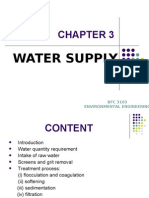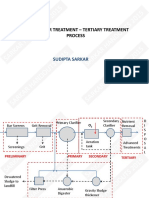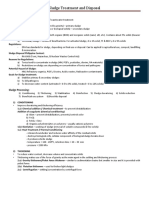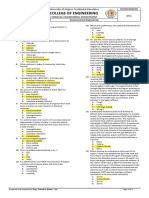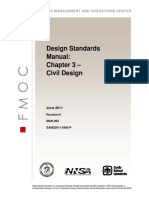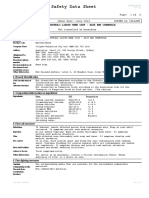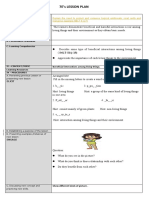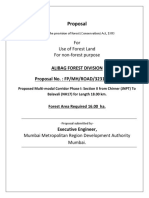Professional Documents
Culture Documents
Chapter One
Chapter One
Uploaded by
TesfayeOriginal Title
Copyright
Available Formats
Share this document
Did you find this document useful?
Is this content inappropriate?
Report this DocumentCopyright:
Available Formats
Chapter One
Chapter One
Uploaded by
TesfayeCopyright:
Available Formats
Sewage treatment
Lecture Note
CHAPTER ONE
INTRODUCTION TO WASTEWATER TREATMENT
1.1 General about Wastewater Treatment
Wastewater collected from urban areas and from different industries must ultimately be returned
to receiving water bodies or to the land. The complex question of which contaminants in
wastewater must be removed is to protect the environment and to what extent must be answered
specifically for each case. This requires analyses of local conditions and needs together with the
application of scientific knowledge, engineering judgment based on past experience, and
consideration of federal, state and local requirements and regulations.
The presence of different pollutants in the wastewater makes it almost impossible to treat all the
wastewater in the same manner.
The contaminants (pollutants) in wastewater are removed by physical, chemical and/or biological
means, and the individual methods usually are classified as physical, chemical and biological
unit processes or operations.
Treatment methods in which the application of physical forces predominates are known as
physical unit operations. Typical physical unit operations are: screening, mi
xing, flocculation, sedimentation, flotation, and filtration and membrane filter operations.
Treatment methods in which the removal or conversion of contaminants is brought about by the
addition of chemicals or by other chemical reactions are known as chemical unit processes.
Neutralization, oxidation, reduction, precipitation, gas transfer, adsorption, ion-exchange,
electro-dialysis etc. are the most common examples of these processes used in wastewater
treatment.
Treatment methods in which the removal of contaminants is brought about by biological activity
are known as biological unit processes.
Biological treatment is used primarily to remove the biodegradable organic substances (colloidal
or dissolved) in wastewater. Basically, these substances are converted into gases that can escape
to the atmosphere and into biological cell tissue that can be removed by settling. The most
common approaches in the biological wastewater treatments are: aerobic processes such as
trickling filters, activated sludge, oxidation ponds (or lagoons), and anaerobic processes such as
anaerobic lagoons, sludge digestion, etc.
Usually in the municipal wastewater treatment, but also in other wastewater processing all the
above mentioned unit operations and processes are grouped together to provide what is known as
primary, secondary and tertiary (or advanced) treatment.
DDIT Prepared by Tesfaye A. Page 1
Sewage treatment
Lecture Note
The term primary refers to physical unit operations and in some cases to chemical unit processes;
secondary refers to biological unit processes; and tertiary refers to combinations of all three.
The contaminants of major interest in wastewater and the unit operations and processes or
methods applicable to the removal of these contaminants are shown in Table 2-2.
In addition to the above mentioned classical basic processes, some new directions are also
evident in various specific areas of wastewater treatment, including:
(i) modification in treatment operations, processes and concepts
(ii) the changing nature of the wastewater to be treated
(iii) the problem of industrial wastes
(iv) wastewater treatability studies
(v) environmental and energy concerns
(vi) land treatment
(vii) small and individual onsite systems
Table 2-1 Important contaminants of concern in wastewater treatment
Contaminants Reason for importance
Suspended Suspended solids can lead to the development of sludge deposits and
solids anaerobic conditions when untreated wastewater is discharged in the aquatic
environment
Biodegradable Composed principally of proteins, carbohydrates and fats, biodegradable
organics organics are measured most commonly in terms of BOD and COD. If
discharged untreated to the environment, their biological stabilization can lead
to the depletion of natural oxygen resources and to the development of septic
conditions
Pathogens Communicable diseases can be transmitted by the pathogenic organisms in
wastewater
Nutrients Both nitrogen and phosphorus, along with carbon, are essential nutrients for
growth. When discharged to the water these nutrients can lead to the growth
of undesirable aquatic life. When discharged in excessive amounts on land
they can also lead to the pollution of groundwater
Refractory These organics tend to resist conventional methods of wastewater treatment.
organics Typical examples include surfactants, phenols, and agricultural pesticides
Heavy metals Heavy metals are usually added to wastewater from commercial and industrial
activities and may have to be removed if the wastewater is to be reused
Dissolved Inorganic constituents such as calcium, sodium, and sulfate are added to the
inorganic solids original domestic water supply as a result of water use and may have to be
DDIT Prepared by Tesfaye A. Page 2
Sewage treatment
Lecture Note
removed if the wastewater is to be reused
Source: Metcalf & Eddy, Wastewater engineering
Table 2-2 Unit operations, processes, and treatment systems
Unit Operation, Unit Process, or
Contaminant Classification
Treatment System
Suspended solids Screening and comminution P
Sedimentation P
Flotation P
Filtration P
Coagulation / sedimentation C/P
Land treatment P
Biodegradable Activated sludge B
organics Trickling filters B
Rotating biological contactors B
Aerated lagoons B
Oxidation ponds B
Intermittent sand filtration P/B
Land treatment B/C/P
Physical / chemical P/C
Pathogens Chlorination C
Ozonation C
Land treatment P
Nutrients: Suspended-growth nitrification and denitrification B
Nitrogen Fixed-film nitrification and denitrification B
Ammonia stripping C/P
Ion exchange C
Breakpoint chlorination C
Land treatment B/C/P
Phosphorus Metal salt coagulation/sedimentation C/P
Lime coagulation / sedimentation C/P
Biological/chemical C/P
phosphorus removal B/C
Land treatment C/P
DDIT Prepared by Tesfaye A. Page 3
Sewage treatment
Lecture Note
Refractory organics Carbon adsorption P
Tertiary ozonation C
Land treatment systems P
Heavy metals Chemical precipitation C
Ion exchange C
Land treatment C/P
Dissolved inorganic Ion exchange C
Solids Reverse osmosis P
Electrodialysis C
*B = biological, C = chemical, P = physical.
The wastewater originating from various sources can be broadly divided into two categories:
1. Biodegradable wastewater
The wastes in general have a predominance of biodegradable organic matter, and are generally
treated in a similar manner.
The stabilization of organic matter is accomplished biologically using a variety of
microorganisms. The microorganisms are used to convert the colloidal and dissolved
carbonaceous organic matter into various gases and into cell tissue. Because cell tissue has a
specific gravity slightly greater than that of water, the resulting tissue can be removed from the
treated liquid as sludge by gravity settling.
Based on bacterial relationship to oxygen (ability or inability to utilize oxygen as a terminal
electron acceptor in oxidation/reduction reactions), the microorganisms can be:
DDIT Prepared by Tesfaye A. Page 4
Sewage treatment
Lecture Note
(i) obligate aerobes
(ii) obligate anaerobes
(iii) facultative anaerobes
(iv) denitrifiers
The general term that describes all of the chemical activities performed by a bacterial cell is
metabolism which is divided into catabolism and anabolism. Catabolism includes all the
biochemical processes by which a substrate (food) is degraded to end products with the release
of energy.
Anabolism includes all the biochemical processes by which the bacterium synthesizes new cells.
The type of electron acceptor available for catabolism determines the type of decomposition used
by a mixed culture of microorganisms.
Decomposition of wastes and particularly of wastewater can be:
(i) aerobic decomposition
(ii) anaerobic decomposition
(iii) anoxic decomposition
For aerobic decomposition the molecular oxygen (O2) must be present as the terminal electron
acceptor to proceed by aerobic oxidation. The chemical end-products of aerobic decomposition
are primarily carbon dioxide (CO2), water, and new cell material.
Anoxic decomposition occurs when some microorganisms will use nitrate (NO 3-) as the terminal
electron acceptor in the absence of molecular oxygen. Oxidation by this route is called
denitrification.
In order to achieve anaerobic decomposition, molecular oxygen and nitrate must not be present
as terminal electron acceptors. Sulfate (SO 42-), carbon dioxide, and organic compounds that can
be reduced serve as terminal electron acceptors. The end-products of anaerobic decomposition
are hydrogen sulfide (H2S), mercaptans, methane (CH4), carbon dioxide, ammonia and water.
2. Non-biodegradable wastewater
The non-biological wastes in general and the wastewater in particular are rich in non-
biodegradable matter consisting of solids and liquids in suspended or dissolved form, including
various inorganic and organic, many of which may be highly toxic.
Examples are domestic or industrial wastewater containing excessive dissolved solids
(minerals), inorganic or organic compounds or naturally occurring organics such as humic and
fulvic acids.
Treatment processes are available for removing these contaminants. The physical processes
frequently used in engineered systems include sedimentation, filtration and gas-transfer.
Chemical processes include the usage of different chemicals for wastewater treatment.
Chemicals may be added to alter equilibrium conditions and cause precipitation of undesirable
DDIT Prepared by Tesfaye A. Page 5
Sewage treatment
Lecture Note
species. It should be kept in mind that chemical processes are conversion processes and that
actual removal is accomplished by physically separating the solid, liquid, or gaseous products of
the chemical reactions. The chemical processes frequently used in engineered systems include
neutralization, coagulation, flocculation, chemical precipitation and oxidation & reduction.
Some wastewater must be treated by means of highly sophisticated processes and equipment,
requiring highly skilled operators, and therefore quite expensive. Such processes are physico-
chemical processes and include: demineralization, desalinization, ion-exchange, reverse osmosis,
electro-dialysis, adsorption, evaporation, incineration, etc.
1.2 Objectives of Wastewater Treatment
1. To introduce fundamentals of the wastewater treatment plants and their unit operations
and processes
2. To provide basic design skills and knowledge on the wastewater treatment plants and
their unit operations and processes
3. To experience a design project on a hypothetical wastewater treatment plant
a. Identify kinds and sources of wastewater
b. Describe hazards in wastewater
c. Describe ways of treating wastewater
d. Describe the products of wastewater treatment, including the production and use
of biosolids
The overall objectives of wastewater treatment are associated with the removal of pollutants and
the protection and preservation of our natural resources.
Specific concern is protection of human health by the destruction of pathogenic organisms
present in wastewater prior to treated effluent being discharged to receiving water bodies and
land.
1.3 Wastewater Treatment Standards
Effluents from different establishments should be treated before being discharged to receiving
bodies so that it should be:
1. Free from materials and heat in quantities, concentrations or combinations which are
toxic or harmful to human, animal, aquatic life.
2. Free from anything that will settle in receiving waters forming putrescence or otherwise
objectionable sludge deposits, or that will adversely affect aquatic life.
3. Free from floating debris, oil, scum and other materials in amounts sufficient to be
noticeable in receiving waters;
DDIT Prepared by Tesfaye A. Page 6
Sewage treatment
Lecture Note
4. Free from materials and heat that alone, or in combination with other materials will
produce color, turbidity, taste or odour in sufficient concentration to create a nuisance or
adversely affect aquatic life in receiving waters;
5. Free from nutrients in concentrations that create nuisance growths of aquatic weeds or
algae in the receiving waters.
A significant element in wastewater disposal is the potential environmental impact associated
with it.
Environmental standards are developed to ensure that the impacts of treated wastewater
discharges into ambient waters are acceptable. Standards play a fundamental role in the
determination of the level of wastewater treatment required and in the selection of the discharge
location and outfall structures.
Regulations and procedures vary from one country to another and are continuously reviewed and
updated to reflect growing concern for the protection of ambient waters. The United States
Environmental Protection Agency (USEPA) developed the National Pollutant Discharge
Elimination System (NPDES) permit programme in 1972 to control water pollution by regulating
point sources that discharge pollutants into waters. Accordingly, industrial, municipal, and other
facilities are required to obtain permits if their discharges go directly into surface waters. Under
this programme, secondary treatment standards were established by USEPA for publicly owned
treatment works, governing the performance of secondary wastewater treatment plants. These
technology-based regulations, which apply to all municipal waste-water treatment plants,
represent the minimum level of effluent quality attainable by secondary treatment in terms of
BOD5 and TSS removal.
Specific Limits
Effluents discharged to receiving water bodies should achieved the following minimum
wastewater quality limits:
DDIT Prepared by Tesfaye A. Page 7
Sewage treatment
Lecture Note
Parameter Effluent Limit
BOD5 20mg/l
TSS 30mg/l
Nitrates (as 30mg/l
Nitrogen)
Phosphate 10mg/l
COD 100mg/l
pH 6–9
Faecal coliform 1000MPN/100ml
Residual chlorine 1.5mg/l
MPN- Most Probable Number
1.4 Flow Sheets for Wastewater Treatment Systems
Depending on the contaminants to be removed, an almost limitless number of process
combinations can be developed using the unit operations and processes. The term "flow sheet" is
used to describe a particular combination of unit operations and processes used to achieve a
specific treatment objective. Apart from the analysis of the technical feasibility of the individual
treatment methods, the exact flow-sheets configuration will depend on factors such as:
(1) the needs of the client's needs,
(2) the designer's past experience,
(3) regulatory agency policies on the application of specific treatment methods,
(4) the availability of equipment suppliers,
(5) what use can be made of existing facilities,
(6) the availability of qualified operating personnel,
(7) initial construction costs, and
(8) future operation and maintenance costs
Conventional flow sheets for the treatment of wastewater are presented and discussed below.
The choice of a set of treatment methods depends on several factors, including discharge permits
and available disposal facilities. For example, where an ocean discharge is used, removal of large
debris by screens and of settleable solids by sedimentation may be the only treatment steps that
are required. Where treated effluent is to be discharged to an inland stream, complete treatment
may be required. Discharges to environmentally sensitive lakes, streams, and estuaries may
require additional treatment to remove specific constituents.
Treatment schemes are often identified as primary, secondary, or advanced (also known as
tertiary). In primary treatment, a portion of the suspended solids and organic matter is removed
from the wastewater. This removal is usually accomplished with physical operations such as
screening and sedimentation. The effluent from primary treatment will ordinarily contain
DDIT Prepared by Tesfaye A. Page 8
Sewage treatment
Lecture Note
considerable organic matter and will have a relatively high BOD. The further treatment of the
effluent from primary treatment to remove the residual organic matter and suspended material is
known as secondary treatment. In general, biological processes employing microorganisms are
used to accomplish secondary treatment. The effluent from secondary treatment usually has little
BOD5 and suspended solids and may contain several milligrams per liter of dissolved oxygen.
When required for water reuse or for the control of eutrophication in receiving waters, advanced
(tertiary) treatment is used for the removal of suspended and dissolved materials remaining after
secondary treatment.
Actually, the distinction between primary, secondary, and advanced treatment is rather arbitrary,
as many modern treatment methods incorporate physical, chemical, and biological processes in
the same operation. A more rational approach would be to drop these arbitrary distinctions and to
focus instead on the optimum combinations of operations and processes that must be used to
achieve the required treatment objectives.
Typical flow sheets for the treatment of wastewater are presented in Figure 2-1
DDIT Prepared by Tesfaye A. Page 9
Sewage treatment
Lecture Note
Figure 2-1 Flow chart for wastewater treatment processes
The diagram demonstrates how the treatment plant works and how the different processes are
inter-connected to work as one. Each treatment process in the flow sheet will be discussed in
chapter 4 and 5.
DDIT Prepared by Tesfaye A. Page 10
You might also like
- Ion Exchange Resins and Adsorbents in Chemical Processing: Second EditionFrom EverandIon Exchange Resins and Adsorbents in Chemical Processing: Second EditionRating: 5 out of 5 stars5/5 (1)
- Unicharm India CSR JourneyDocument4 pagesUnicharm India CSR JourneyPrashant MalaviyaNo ratings yet
- Chapter One and TwoDocument24 pagesChapter One and TwoManamno BezaNo ratings yet
- Chapter 1&2 WWTDocument29 pagesChapter 1&2 WWTYohannes HabeshawiNo ratings yet
- Treatment Process Flow SheetsDocument13 pagesTreatment Process Flow Sheetsapi-27499979100% (2)
- CHAPT 3-Water SupplyDocument74 pagesCHAPT 3-Water SupplyJamal MohamedNo ratings yet
- Pollutants in Natural Water and Wastewater: Toxicity Pathogens Heavy Metals Nitrogen CompoundsDocument3 pagesPollutants in Natural Water and Wastewater: Toxicity Pathogens Heavy Metals Nitrogen CompoundsAstrid AngelNo ratings yet
- CVL100:Environmental Science (2-0-0) : Introduction To Water Pollution Lec1: Jan 04,2022Document17 pagesCVL100:Environmental Science (2-0-0) : Introduction To Water Pollution Lec1: Jan 04,2022Chand PatelNo ratings yet
- Environmental Pollution ControlDocument28 pagesEnvironmental Pollution ControlPrudhviNo ratings yet
- Asst - Prof. Dr. Nuttawan YoswathanaDocument19 pagesAsst - Prof. Dr. Nuttawan YoswathanaSUWIPHA DAPHANo ratings yet
- Lec 1Document42 pagesLec 1singhheemani06No ratings yet
- Tertiary Treatment PDFDocument13 pagesTertiary Treatment PDFNazaf AhzamNo ratings yet
- Biochar PDFDocument13 pagesBiochar PDFSuyash JainNo ratings yet
- Tanning IndustryDocument23 pagesTanning IndustryVidisha JhaNo ratings yet
- Chapter 1 & 2Document49 pagesChapter 1 & 2Manamno BezaNo ratings yet
- Overview of Biological TreatmentDocument18 pagesOverview of Biological TreatmentMd. Naimul Islam SanyNo ratings yet
- Industrial Waste: Che 513: Industrial Waste Management & Control Engr. MMM Boado, Ms EneDocument9 pagesIndustrial Waste: Che 513: Industrial Waste Management & Control Engr. MMM Boado, Ms EneHey YoNo ratings yet
- 00 - WWT EngineeringDocument188 pages00 - WWT EngineeringFaisal Mumtaz100% (1)
- 26-Waste Disposal-03-03-2023Document19 pages26-Waste Disposal-03-03-2023Back upNo ratings yet
- Mixotrophic Denitrification Processes in Basalt Fiber Bio-Carriers Drive Effective Treatment of Low Carbon/nitrogen Lithium Slurry WastewaterDocument11 pagesMixotrophic Denitrification Processes in Basalt Fiber Bio-Carriers Drive Effective Treatment of Low Carbon/nitrogen Lithium Slurry WastewaterMuhammad ArslanNo ratings yet
- Wastewater Treatment-BlanksDocument17 pagesWastewater Treatment-BlanksAsifNo ratings yet
- Removal of Heavy Metals From Drinking Water Supplies Through The Ion Exchange Membrane BioreactorDocument3 pagesRemoval of Heavy Metals From Drinking Water Supplies Through The Ion Exchange Membrane BioreactorYesid Tapiero MartínezNo ratings yet
- Chapter 4-Industrial Wastewater Treatment ProcessDocument63 pagesChapter 4-Industrial Wastewater Treatment ProcessFadhli JapryNo ratings yet
- Landfill Leachate TreatmentDocument52 pagesLandfill Leachate TreatmentASWIN GEORGENo ratings yet
- Bashir 2009Document8 pagesBashir 2009DHANVI MENGARNo ratings yet
- CPE655 Solid Waste ManagementDocument108 pagesCPE655 Solid Waste ManagementAmirah SufianNo ratings yet
- Adsorption of Phosphate Ions From Aqueous Solution by Modified Bentonite With Magnesium Hydroxide MG (OH) 2, 8trDocument8 pagesAdsorption of Phosphate Ions From Aqueous Solution by Modified Bentonite With Magnesium Hydroxide MG (OH) 2, 8trAnonymous qqgN8jNo ratings yet
- Chapter 3 Introduction To Treatment ProcessesDocument5 pagesChapter 3 Introduction To Treatment ProcessesShita AlemieNo ratings yet
- Chapter 3Document5 pagesChapter 3Hussen MohammedNo ratings yet
- Kabul Polytechnic University Water Supply and Environmental Engineering DepartmentDocument25 pagesKabul Polytechnic University Water Supply and Environmental Engineering DepartmentMukhtar Hussain MohammadiNo ratings yet
- Carbon Based Materials: A Promising Approach For Water Depollution by Electrochemical Advanced Oxidation ProcessesDocument36 pagesCarbon Based Materials: A Promising Approach For Water Depollution by Electrochemical Advanced Oxidation ProcessesmektanNo ratings yet
- Cive / Cbe 540 Bioremediation: Sybil SharvelleDocument22 pagesCive / Cbe 540 Bioremediation: Sybil Sharvelledavid_tomy_1No ratings yet
- S Announcement 15750Document4 pagesS Announcement 15750Sarah SanchezNo ratings yet
- 10 EnviDocument8 pages10 EnviAaron RoyNo ratings yet
- 7 - D21WW - Wastewater Treatment BDocument48 pages7 - D21WW - Wastewater Treatment BDominic WaldronNo ratings yet
- Sludge TreatmentDocument4 pagesSludge TreatmentRicaMyrivilleArellagaNo ratings yet
- The Leachate Treatment by Using NaturalDocument4 pagesThe Leachate Treatment by Using NaturalA Nicole Rodríguez OportoNo ratings yet
- Organo BentoniteDocument4 pagesOrgano Bentoniteveenau 1No ratings yet
- IgtDocument2 pagesIgtPeter AndrewNo ratings yet
- Modern Wastewater TreatmentDocument39 pagesModern Wastewater TreatmentAulia Devi PurnamaNo ratings yet
- DecompositionDocument19 pagesDecompositionMATHIXNo ratings yet
- A Review of Leachate Treatment TechniqueDocument10 pagesA Review of Leachate Treatment TechniqueKristina DukicNo ratings yet
- SMWW 1080Document3 pagesSMWW 1080milagrosgvyNo ratings yet
- Append ADocument12 pagesAppend AK4No ratings yet
- Water GeochemistryDocument25 pagesWater GeochemistrygeophyprofessorNo ratings yet
- Chapter 1: Introduction To Treatment Processes: Wastewater (Sewage)Document66 pagesChapter 1: Introduction To Treatment Processes: Wastewater (Sewage)ashe zinabNo ratings yet
- WT Full Slide 2013Document193 pagesWT Full Slide 2013Kibrom TsegayNo ratings yet
- Initial Biochar Properties Related To The Removal of As, Se, PB, CD, Cu, PDFDocument9 pagesInitial Biochar Properties Related To The Removal of As, Se, PB, CD, Cu, PDFAhmed AliNo ratings yet
- Investigation Anaerobic Processes Septic Tank Wastewater TreatmentDocument5 pagesInvestigation Anaerobic Processes Septic Tank Wastewater TreatmentSaj Bhai100% (1)
- Moduel 4 - SedimentationDocument28 pagesModuel 4 - SedimentationjagmalNo ratings yet
- Tp1.1 IntroductionDocument14 pagesTp1.1 Introductionmayhem65No ratings yet
- Sub: Essentials of Environmental ScienceDocument8 pagesSub: Essentials of Environmental ScienceBhishma BrahmbhattNo ratings yet
- Agua Residuales - 2021Document16 pagesAgua Residuales - 2021Sofía BárcenasNo ratings yet
- CEB 30503 CHPTR 2Document42 pagesCEB 30503 CHPTR 2nazirah abdul kareemNo ratings yet
- NCERT Solutions For Class 12 March 30 Biology Chapter 16 Environmental IssuesDocument7 pagesNCERT Solutions For Class 12 March 30 Biology Chapter 16 Environmental IssuesVijayalakshmi DhanabalNo ratings yet
- Chemical Engineering Journal: Bingjie Liu, Xin LV, Xianghong Meng, Guangli Yu, Dongfeng WangDocument8 pagesChemical Engineering Journal: Bingjie Liu, Xin LV, Xianghong Meng, Guangli Yu, Dongfeng Wangs-hadnineNo ratings yet
- TechDocument6 pagesTechRanveer SinghNo ratings yet
- Unit Operations of Wastewater Treatment: ReferencesDocument15 pagesUnit Operations of Wastewater Treatment: ReferencesVina Belbider SabulaoNo ratings yet
- Introduction To WWDocument22 pagesIntroduction To WWOmaya TariqNo ratings yet
- Pollution of Lakes and Rivers: A Paleoenvironmental PerspectiveFrom EverandPollution of Lakes and Rivers: A Paleoenvironmental PerspectiveNo ratings yet
- Nitrification and Denitrification in the Activated Sludge ProcessFrom EverandNitrification and Denitrification in the Activated Sludge ProcessNo ratings yet
- General Presentation WS TechnicalDocument33 pagesGeneral Presentation WS TechnicalTesfayeNo ratings yet
- Bachara Network System DesignDocument24 pagesBachara Network System DesignTesfayeNo ratings yet
- Bachara Network Water PointsDocument5 pagesBachara Network Water PointsTesfayeNo ratings yet
- WS Construction Contract Eng Amh March 21Document6 pagesWS Construction Contract Eng Amh March 21TesfayeNo ratings yet
- Chapter Six SewageDocument16 pagesChapter Six SewageTesfayeNo ratings yet
- Chapter FiveDocument4 pagesChapter FiveTesfayeNo ratings yet
- CMT AssignmentDocument1 pageCMT AssignmentTesfayeNo ratings yet
- Normal Consistency or Standard Consistency of Cement Test Procedure With Apparatus List and Lab ReportDocument7 pagesNormal Consistency or Standard Consistency of Cement Test Procedure With Apparatus List and Lab ReportTesfayeNo ratings yet
- Initial and Final Setting Time of CementDocument20 pagesInitial and Final Setting Time of CementTesfayeNo ratings yet
- Design Standards Manual: Chapter 3 - Civil Design: Facilities Management and Operations CenterDocument31 pagesDesign Standards Manual: Chapter 3 - Civil Design: Facilities Management and Operations CenterTumulak IanNo ratings yet
- Organism and Populations: Mind MapDocument73 pagesOrganism and Populations: Mind MapIndu YadavNo ratings yet
- Quotation For Mineral Water Plant 2000 LPH Full Line Mr. Naveen Ref No 11385Document60 pagesQuotation For Mineral Water Plant 2000 LPH Full Line Mr. Naveen Ref No 11385Anil Kumar A NNo ratings yet
- Third Party Utility Infrastructure Installation in State Controlled Roads Technical GuidelinesDocument27 pagesThird Party Utility Infrastructure Installation in State Controlled Roads Technical Guidelinesjaouad id boubkerNo ratings yet
- Jabon de Aloe Vera Hoja de SeguridadDocument5 pagesJabon de Aloe Vera Hoja de SeguridadCharlie RmNo ratings yet
- Wacker Neuson Track Excavators Ez53 Operator Service Manual Spare Parts CatalogDocument22 pagesWacker Neuson Track Excavators Ez53 Operator Service Manual Spare Parts Catalogemilyfaulkner230891owt100% (121)
- EU Renewable Energy Directive RevisionDocument10 pagesEU Renewable Energy Directive RevisionThe International Council on Clean TransportationNo ratings yet
- PASPALUM: Jurnal Ilmiah Pertanian: Vol. 9 No. 1 Bulan Maret Tahun 2021Document9 pagesPASPALUM: Jurnal Ilmiah Pertanian: Vol. 9 No. 1 Bulan Maret Tahun 2021Vivi NovitaNo ratings yet
- S A Bài Unit 6, 7, 8 - NTPQDocument10 pagesS A Bài Unit 6, 7, 8 - NTPQPhương QuỳnhNo ratings yet
- Cle6007 Energy,-Environment-And-climate-change TH 1.1 47 Cle6007Document2 pagesCle6007 Energy,-Environment-And-climate-change TH 1.1 47 Cle6007Aninda KanjilalNo ratings yet
- Medeiros Et Al. (2022) (Remote Sensing)Document16 pagesMedeiros Et Al. (2022) (Remote Sensing)Carlos CostaNo ratings yet
- Indicator Plant Species List W21Document2 pagesIndicator Plant Species List W21charise pelanNo ratings yet
- 7 E's Lesson PlanDocument4 pages7 E's Lesson PlanLendy Mae Sucayre100% (1)
- Meiker Alejandro Pulido - 50Document5 pagesMeiker Alejandro Pulido - 50edwinNo ratings yet
- Proposal - GROUP 2Document10 pagesProposal - GROUP 2Nash CasunggayNo ratings yet
- Freshwater Aquaculture: Advantages DisadvantagesDocument7 pagesFreshwater Aquaculture: Advantages DisadvantagesMakoshaneNo ratings yet
- For Use of Forest Land For Non-Forest Purpose: ProposalDocument98 pagesFor Use of Forest Land For Non-Forest Purpose: ProposalgopalNo ratings yet
- Cavicchioli 18Document9 pagesCavicchioli 18Bruno BossoNo ratings yet
- Population GeneticsDocument37 pagesPopulation GeneticsSITI BAZILAH BINTI BILAK KPM-GuruNo ratings yet
- Economics Semester IIDocument7 pagesEconomics Semester IItaahanaganurNo ratings yet
- MSDS - Sodium Hydrogen Sulfate MonohydrateDocument7 pagesMSDS - Sodium Hydrogen Sulfate MonohydrateBigbearBigbearNo ratings yet
- Geological Profile PDFDocument14 pagesGeological Profile PDFKathleen Anne LandarNo ratings yet
- Biological Classification 3Document3 pagesBiological Classification 3Dr. D. kumar Harshit -apexNo ratings yet
- Additional Guidelines For The Ongoing Centrally Sponsored Scheme of Project Tiger Relating To New ComponentsDocument18 pagesAdditional Guidelines For The Ongoing Centrally Sponsored Scheme of Project Tiger Relating To New Componentskuldeep soniNo ratings yet
- SPEECHDocument1 pageSPEECHJazmine CapuliNo ratings yet
- Kalinisan Post Activity ReportDocument3 pagesKalinisan Post Activity ReportGenoo Ang Akong KenabohiNo ratings yet
- Lobstah Gahden Speak Out Against Pollution With A Wicked Awesome Boston Accent Alli Brydon Full ChapterDocument65 pagesLobstah Gahden Speak Out Against Pollution With A Wicked Awesome Boston Accent Alli Brydon Full Chapterdiane.jurado739100% (9)
- Swale StructuresDocument24 pagesSwale Structureskechata6998No ratings yet
- Business Model For Social Enterprise - Design Principles For Business Models of Social EnterprisesDocument25 pagesBusiness Model For Social Enterprise - Design Principles For Business Models of Social EnterprisesadeebaNo ratings yet





